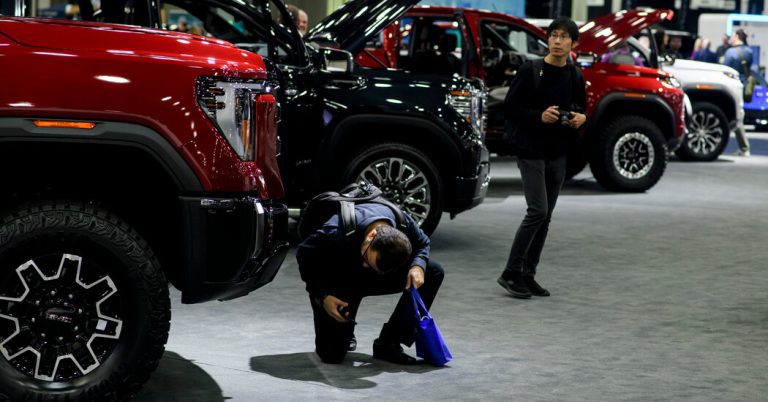After enjoying a strong recovery in sales in 2023, the auto industry appears headed for slower growth this year as consumers struggle with rising interest rates and high prices for new cars and light trucks.
Edmunds, a market researcher, expects the industry to sell 15.7 million vehicles this year. That would equate to a modest increase from the 15.5 million sold last year, when sales rose 12%.
“There’s definitely pent-up demand out there because people have been holding off on purchases for a while,” said Jessica Caldwell, chief information officer at Edmunds. “But given the credit situation, we don’t think the industry will see a ton of growth this year.”
Since the coronavirus pandemic, automakers have struggled with shortages of critical parts that have prevented them from producing as many vehicles as consumers wanted to buy. In 2023, shortages, especially for computer chips, finally eased, allowing production to return to more normal levels.
However, over the past year, the Federal Reserve has raised interest rates significantly, which has significantly increased costs for car buyers.
For years, many people took advantage of zero percent loans to buy vehicles, even as prices rose. But such deals, offered by automakers to move inventory, have all but disappeared in the wake of the Fed’s rate hikes. In the fourth quarter of 2023, sales of new vehicles with zero percent financing accounted for just 2.3 percent of all sales, according to Edmunds.
Monthly payments are at near record levels. In the fourth quarter, the average monthly payment for new cars was $739, up from $717 in the same period a year ago.
Several automakers had hoped that a rapid increase in sales of new electric vehicles would propel the industry to profits in 2024 and 2025, but those cars and trucks haven’t taken off as quickly as many analysts and executives had hoped.
In 2023, sales of battery-powered models in the United States surpassed one million vehicles for the first time, and Cox Automotive, another research firm, expects sales to reach 1.5 million this year. But General Motors, Ford Motor, Volkswagen and other manufacturers expected an even faster rise.
However, consumers have balked at the high prices of many of the newer electric models. Many drivers are also reluctant to change battery power because they are not sure they will be able to find enough places to refuel quickly. This forced the automakers to reset their plans.
GM once predicted it would produce 400,000 electric vehicles by mid-2024, but has now abandoned that goal and delayed production of some electric models.
Ford aimed to have enough factory capacity by the end of 2024 to build 600,000 battery-powered vehicles a year, but recently scaled back production plans for the electric F-150 Lightning and its electric sports utility vehicle, the Mustang Mach-E. .
On Wednesday, GM said its new vehicle sales in the United States rose 14 percent last year. The company sold 2.6 million cars and light trucks in 2023, up from 2.3 million in 2022, when chip shortages limited production.
GM sold about 76,000 electric vehicles, up from 39,000 in 2022. But most were Chevrolet Bolts, a model the company recently stopped making. Only about 13,000 were vehicles based on newer battery technology that GM hoped would make its electric vehicles affordable to many more car buyers.
GM’s fourth-quarter sales were relatively weak. They were up just 0.3 percent from the same period a year earlier and down 7 percent compared to the third quarter of 2023. The company said sales of several key models were curtailed by a strike at some of its factories from United Automobile Workers union.
Separately, Toyota Motor, the second-biggest car seller in the United States after GM, said its 2023 sales rose 7 percent to 2.2 million vehicles. The company’s sales in the fourth quarter were 15.4% higher than in the same quarter last year and about 5% higher than in the third quarter.
Stellantis, maker of Chrysler, Ram and Jeep vehicles, said it sold 1.5 million cars and trucks in 2023, about 1 percent less than last year. The company plans to introduce eight new electric vehicles this year and aims to have battery-powered models account for half of its North American sales by the end of the decade.
Honda, Hyundai and Kia also on Wednesday reported strong U.S. sales for 2023.And on Tuesday, Tesla, which dominates the electric car industry in the United States, said it sold 1.8 million cars worldwide last year, up by 38% from 2022.
Ford is expected to announce its overall sales on Thursday.




